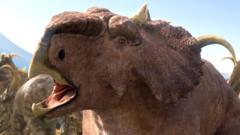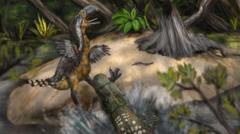Hidden beneath the dense foliage of Alberta's Pipestone Creek lies an enormous graveyard, a haunting remnant of prehistoric times. Thousands of dinosaurs met their end here, reportedly wiped out in a sudden catastrophe that has left scientists grappling with a 72-million-year-old mystery. This site, unforgettably nicknamed the "River of Death", has become the focus for a dedicated team of palaeontologists aiming to uncover the truth behind this ancient tragedy.
Led by Professor Emily Bamforth, the excavation begins with the hefty swing of a sledgehammer. The rock layer covering the bones is formidable, but soon enough, the team reveals a treasure trove of fossilized remains. "That fragment over there is likely a hip bone," Prof. Bamforth states, painstakingly working to expose various bones that provide crucial insights into this remarkable event.
The remnants belong to Pachyrhinosaurus, a dinosaur prominent during the Late Cretaceous epoch. Featured in a new BBC series, "Walking With Dinosaurs," these creatures are known for their large heads adorned with distinct horns and a nasal bump they called a "boss." The excavation area boasts an impressive density of fossils, with Prof. Bamforth estimating as many as 300 bones can be found in a single square meter of land.
The fossils represent a significant moment frozen in time. Analysis indicates that this herd of Pachyrhinosaurus was migrating from winter grazing grounds to summer pastures, likely drawn by a climate rich in vegetation back in that prehistoric world. According to Prof. Bamforth, "It’s a unique community snapshot, an immense sample size that is rarely found in the fossil record.”
But this isn’t the only site yielding remarkable findings; further exploration at the nearby Deadfall Hills has unearthed even larger dinosaur bones, including those from Edmontosaurus, a substantial herbivore. Collectively, these discoveries help researchers appreciate the sweeping diversity of life that once thrived in this region.
The pressing question that haunts palaeontologists is the cause behind the mass death of these creatures. Evidence strongly indicates that a sudden, devastating flash flood was responsible. "The herd likely became caught in an overwhelming torrent that washed over them," states Prof. Bamforth. "With their numbers and bulk, they would have struggled to move and swim effectively."
Visual clues, including sediment patterns preserved in the rock, tell a story of the chaos that ensued during that catastrophic day. Each visit to Pipestone Creek reveals more secrets, further chronicling the life and extinction of the Pachyrhinosaurus.
As the team winds down their current session, they are acutely aware of the treasures still buried within this extraordinary graveyard. Despite the enormity of what they’ve uncovered, there is an acknowledgment among scientists that much work remains. "Every expedition surfaces new findings," asserts Prof Bamforth. The journey into this prehistoric past is just beginning.
Catch the compelling new series "Walking With Dinosaurs" premiering Sunday, May 25 at 18:25 BST on BBC One, with all episodes available on BBC iPlayer.




















